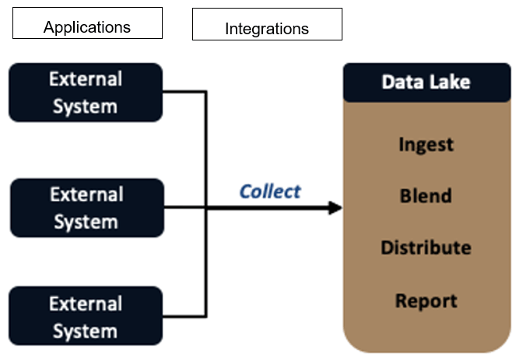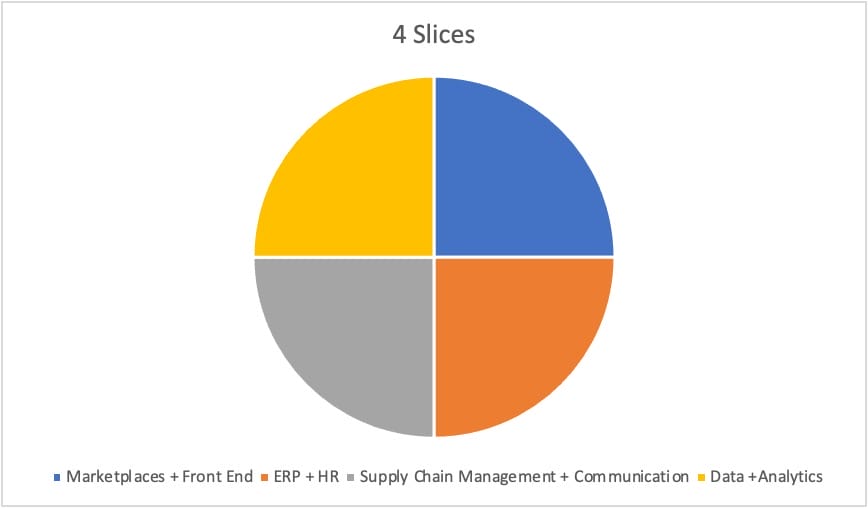Background:
The software industry is buzzing with a myriad of new solutions spanning vastly different functional areas, and it should be as our whole world is evolving so quickly. COVID brought about new work from home business formats, supply chains are shaken up, and companies are rapidly investing in different software tools to drive improved automation in our increasingly digital world. Speaking with hundreds of businesses each month about their existing and future tech stack visions, there are different opinions and approaches to leveraging technology depending on their industry sector and maturity.
My wife and I make homemade pizzas a lot together. We were making pizzas the other night talking about work and somehow, we got into a silly pizza + software analogy that started to make more sense the more we continued the thread. We basically were using “ingredients” and “number of slices” to analogize the different types of software on the market, and the different systems a business needs to operate.
This article leverages our pizza metaphors to explain types of business management software on the market and strategies to consider when investing in software to run the business.
Three Ingredients:
Ultimately there are only three layers of ingredients that go into the pizza – what’s in the bread, what’s in the sauce, what’s going on top. Yes, I understand fancy New York pizzerias use far more than three ingredients, as does my wife, but I like to keep it simple, bread, Rao’s Tomato sauce, cheese.
Like pizza ideology and recipes, there are hundreds of different business management software tools (ingredients) on the market, but we can simplify them down into three main ingredient buckets/layers: the application layer, the middleware/integration layer, and the data lake layer.

The Application Layer – AKA The Toppings: When people order pizzas, they generally are most focused on what kind of toppings they want on the pizza. There are hundreds of topping options – meats, cheeses, veggies, etc. Similarly, most businesses will focus first on the application layer and considering how they can move away from disparate email chains, excel sheets, and pen/paper operations. Applications can be point solutions to address specific use cases or micro process areas, or they can be wider horizontal tools to manage many different process areas. Applications vary by industry and business model as the overall suite of applications a direct-to-consumer online apparel brand needs is quite different from a pharmaceutical supply wholesaler. Applications examples range from Enterprise Resource Planning (ERP) systems, to Supply Chain Management Systems (SCM), to Customer Relationship Management (CRM), etc.
The Integration Layer – AKA The Sauce: Just as the pizza sauce sits in between the toppings and dough, the integration layer is comprised of software solutions that sit between each application and connect the application layer with the data lake. Ultimately, the role of the integration layer is to oversee the pushing and pulling of data to complete cohesive process tracks across numerous applications. The integration layer could be custom built integrations or middleware software products from companies like Celigo, Dell Boomi, Jitterbit, or FarApp.
To better understand the role of the integration layer, let’s consider an example company that sells pizza sauce on Amazon, a Shopify website and a brick-and-mortar store. As customers place orders across each selling channel, the order data needs to flow into fulfilment and accounting systems to decrement inventory from available to sell, ship the product to the customer, and account for the sale. There is a layer of software that monitors Amazon and Shopify for incoming new transactions and then facilitates a mapping exercise to transcribe relevant transaction data into subsequent application layer systems such as an ERP or WMS. The integration layer solutions may also be in charge of pushing mass data from the application layer into the data lake for robust data analysis and custom reporting.
The Data Lake Layer – AKA The Dough: While most people focus on toppings when ordering their pizza, the real pizza connoisseurs also consider the base layer – deep-dish, thin crust, sicilian, stuffed crust, etc. Businesses think about the data lake layer in a similar fashion. Start-ups and SMBs will generally focus first on creating cohesive sound business processes leveraging application and integration solutions and then as they scale, will look to data warehouse, data lake, and data modeling solutions. This class of solutions aggregates pools of data, cleanses the data, and structures the data to drive meaningful predictive insights. For example, sales velocity data from multiple products sold across multiple marketplaces may be layered on top of specific employee cost centers, with a growth rate applied to predict how to optimize and hire for future operations. The Data Lake Layer pulls data from multiple systems, cleanses it, and then provides actionable and predictive insights.
4 Slices – In my opinion, a 4-slice pizza with larger slices is better than an 8-slice pizza. When you are making homemade pies, candidly, it takes skill to make a large enough pie with 8 quality slices. Similarly, it is my opinion that managing a smaller subset of core software systems to run the business, is a better route than managing an application hairball of best in breed tools. More specifically, business owners and operators have opinions somewhere on the spectrum between “best in breed – more systems is fine” and “few select systems to rule them all – integrations are frustrating and break”. While the software industry continuously improves and disrupts itself, integrations are very challenging to manage as systems roll out so many new updates to stay competitive and subsequently, your integrations need to be managed and updated to work effectively.
In my opinion, below are the four main software solution buckets that businesses should invest in:

Marketplaces + Front End: You need platforms on which to sell products. Amazon, Walmart, Jet.com, New Egg are all marketplaces companies build accounts on and sell products through. Shopify, Magento, Woo Commerce, and Wix are ecommerce applications. Mailchimp, Klaviyo, Salesforce, and Hubspot are sales and marketing automation solutions.
ERP + HR: You need finance and accounting solutions like Quickbooks, Xero, NetSuite, Sage, etc. You need HR solutions like ADP, Insperity, SuitePeople, Fideltiy.
SCM + Communication: You need solutions to manage inventory, vendors, purchase orders, invoices, production, sourcing, product development, and internal, client, vendor/supplier communication solutions to effectively execute on the business. The GRID (cough cough – best and most all encompassing out there), Slack, email, google suite, PLMs (like Centric and adobe), SAP apps, and Source Day are examples of this solution category.
Data + Analytics: You need solutions to mass dump, cleanse, model, and analyze data across all processes and data occurring in the application and integration layer solutions. AWS data lake services, SQL databases, etc are examples of this solution category.

Bobby Hamill is the VP of Sales at Suuchi Inc. With over five years experience at Netsuite, Bobby leads the Suuchi team to help hundreds of businesses take the first step to a digital future for their supply chains. Learn more about Bobby.
